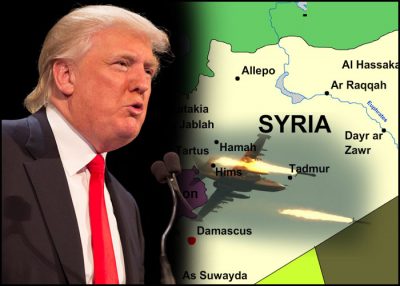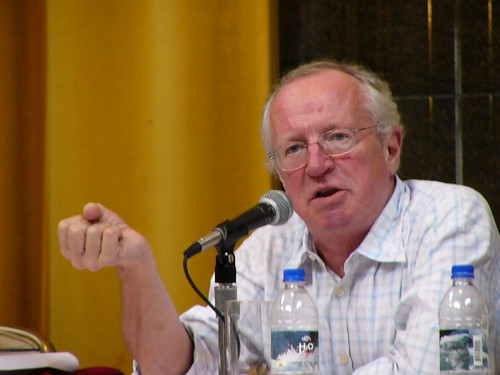The (Fake) Race to Defeat ISIS: Can Trump Salvage His Presidency in Syria’s War?

The political noose is tightening around Trump’s neck, and he’s got only one way out: war. The U.S. involvement in the Syrian war is accelerating as Trump’s talons dig deeper into the conflict. If he successfully clutches his prey he stands a chance of clinging to the presidency.
The Democrats, now circling a wounded Trump, will happily feast instead on a rotting Syria: the only thing that can keep the Democrats from destroying Trump is if Trump destroys Syria.
Trump’s strategy is based on how Democrats reacted after his first attack on the Syrian government on April 6th: they paused their toothless “resistance” to celebrate his bombing. Trump, at his most dangerous, exposed the Democrats at their weakest.
Now Trump has struck the Syrian government again: on May 18th U.S. fighter jets attacked the Syrian military in Eastern Syria, from a new U.S. military base functioning inside Syrian territory controlled by the Syrian Kurds, where there are at least 1,000 U.S. active troops.

Although the U.S. media underplayed Trump’s recent attack —— or ignored it completely — legendary U.K. Middle East journalist Robert Fisk (image on the right, source: Online Journalism Blog) explained the significance:
“…what was described by the Americans as a minor action was part of a far more important struggle between the US and the Syrian regime for control of the south-eastern frontier of Syria…”
Yes, the U.S. is already at war with the Syrian government for control of Syrian territory. The U.S. war on ISIS in Syria was never about ISIS, but about gaining a foothold directly inside Syria. Many pundits dismissed Trump’s initial attack on the Syrian government as “symbolic,” when in fact it began a new war. The New York Times confirms the motive of Trump’s war:
“Two competing coalitions that aim to defeat the Islamic State — one [Kurdish and U.S. fighters] backed by American air power, the other [the Syrian government] by Russian warplanes — are racing to the same goal.”
What is this goal?
“…[there is an] urgency among the competing coalitions fighting the Islamic State to be the first in southeast Syria to defeat the group [ISIS] and to occupy the power vacuum that its defeat would leave….Eastern Syria and the area around Deir al-Zour are mostly unpopulated desert, but they have Syria’s modest oil reserves…The area is strategically important to the United States, which wants to stabilize Iraq where it has a long-term military and political investment, and to Russia, which wants to strengthen the Syrian government’s control of as much territory as possible.”
In summary: the U.S. military wants to “occupy” the “power vacuum” left by ISIS, because Syrian territory is “strategically important” to the United States.
The war isn’t about ISIS because the U.S. military isn’t needed to defeat ISIS in Syria, since the group was doomed the day that Turkey decided to close ranks against them — by sealing their border with Syria — instead of openly supporting them as they had for several years.

US Army armoured vehicles in Syria (Source: Twitter)
Consequently, the Syrian government — with Russian and Iranian support — has no problem mopping up ISIS in Syria, and they’re racing to do it first before the U.S.-Kurdish alliance claims the territory for itself.
Establishment Democrats are cheer-leading Trump’s war goals in private, which is why they’re not denouncing them in public. The Democrat-friendly New York Times published a revealing op-ed entitled “A Trump Doctrine for the Middle East?” In it the writer applauds Trump’s war aims:
“Despite the controversies at home, Mr. Trump may come away with a legacy-cementing achievement: a Trump Doctrine for the Middle East…it is false that American ‘soft power’ is the key to stabilizing the [middle east] region. Our ideals, such as promoting democracy, will work to our advantage only if we first restore order — a project that rests on American hard power [military intervention]. What’s more, the use of force is not inherently counterproductive…”
The article explains that Obama’s “soft power” (the Syrian proxy war) failed and that Trump aims to “restore order” with “hard power” (direct military intervention). As Trump’s bombs fall heavier Democrats will scramble to support a wider war that, crazily, increasingly threatens direct confrontation with Russia. The Russian government loudly denounced Trump’s most recent bombing against the Syrian government, and sent more Russian troops to the region in response.
The U.S. war against ISIS in Syria has always been a pretext to undermine the Syrian and Iranian governments. Robert Fisk explains:
“Cutting Syria off from Iraq – and thus from Iran – appears to be a far more immediate operational aim of US forces in Syria than the elimination of the [ISIS] Sunni ‘Caliphate’ cult that Washington claims to be its principal enemy in the Middle East.”
How might this “race to defeat ISIS” end? Trump’s ominous trip to Saudi Arabia gives some insight into the Trump Doctrine. Trump made an enormous arms deal with Saudi Arabia worth $350 billion over 10 years, and wants the Saudis to use the money to co-lead an “Arab NATO” [military alliance]. Who will this alliance be aimed against? The Trump administration made it known that Iran was the main target, and thus Syria is the appetizer.
In a separate article Robert Fisk discussed Trump’s Saudi visit:
“The aim, however, is simple: to prepare the Sunni Muslims [the gulf monarchy U.S. allies and others] of the Middle East for war against the Shia Muslims [Iran, Syria, Hezbollah]. With help from Israel, of course.”
This is the real reason Trump prioritized Saudi Arabia as the always-important first stop on his initial trip abroad: Trump is clearly stating his commitment to the totalitarian monarchies, who main priorities are the destruction of its regional enemies: Yemen, Syria, and Iran.
This “Arab NATO” is meant to act as a U.S. puppet army in the way that ‘official’ NATO does in Europe, and the African Union’s “Standby Force” does in Africa, where U.S. allies share the responsibility of repressing neighbor states who defy U.S. interests, i.e. they refuse to abandon their political-economic self determination.

Source: Middle East Institute
A U.S.-led “Arab NATO” wasn’t previously impossible because the U.S. is universally hated across the Middle East, for its longstanding alliance with Israel combined with its recent annihilation of Afghanistan, Iraq, and Libya. The openness in which the Gulf monarchies are trying to form this alliance shows just how distanced from and hated by their own residents, who are prevented from expressing their hatred through elections or public protest.
The Trump-led alliance is especially foreboding because U.S. allies in the region feel deeply betrayed by Obama’s Middle East approach; they want concrete assurances the betrayal won’t be repeated, since U.S. allies risked a lot in regime change in Syria after Obama ensured them that regime change would be a safe bet. Trump’s visit means, in practice, a fresh commitment to Assad’s downfall and renewed hostilities with Iran, nuclear deal be damned.
Trump’s current war strategy in Syria is similar to President Bush Sr.’s experiment in Iraq after the 1991 Gulf War: he used a no-fly zone in Kurdish-majority northern Iraq that de-facto partitioned the country, allowing the Kurds to take power where they remain in power today, as an important U.S. puppet. The partitioning of Iraq helped weaken the country prior to the 2003 U.S. invasion.
The Syrian Kurds are now being armed with U.S. weaponry and given similar promises as their Iraqi counterparts received, but the Syrian Kurds are rightfully nervous about their new alliance.
In their desperate fight against ISIS the Kurds have accepted an alliance with the world’s military superpower: the Kurdish homeland is infested with rats and they invited a tiger to deal with the problem; but once the rats are dead the tiger will stay hungry. The Kurds also live next to another starving Tiger, the Turkish Government.
The history of the Kurds is one of constant betrayals by larger powers. And now they are pleading on the pages of The New York Times not to be betrayed again, since they see the writing on the wall:
“…[President Trump] give us your word that even after Raqqa’s liberation [in Syria] you will prevent attempts by Turkey to destroy what we’ve built here.”
Of course Trump’s “word” is meaningless (and even this he won’t give publicly). The Kurds are being used as battlefield pawns in a greater game. As Trump aligns with the Kurds in Syria, he simultaneously calls the Turkish Kurds “terrorists,” even though the Turkish and Syrian Kurds are closely aligned ideologically and militarily.
Like all “boots on the ground,” the Kurds are most useful to the U.S. as cannon fodder, while more powerful people profit from the fighting. The political power of the Kurds pales in comparison to their enemy Turkey, whose government has long-term interests (the destruction of the Kurds) that will outlast the short-term military objectives Trump.
The above contradictions are sharpening across the Middle East, nearing the point of yet another explosion. The Trump Doctrine is a flamethrower at a gas station that can instantly spark an even greater conflagration, beyond the horrors we’ve already witnessed across the Middle East. If the Trump resistance movement in the United States doesn’t quickly prioritize a real anti war strategy, there will be little resistance left to speak of as we descend into war.
Shamus Cooke is a social service worker, trade unionist, and writer for Workers Action (www.workerscompass.org). He can be reached at shamuscooke@gmail.

